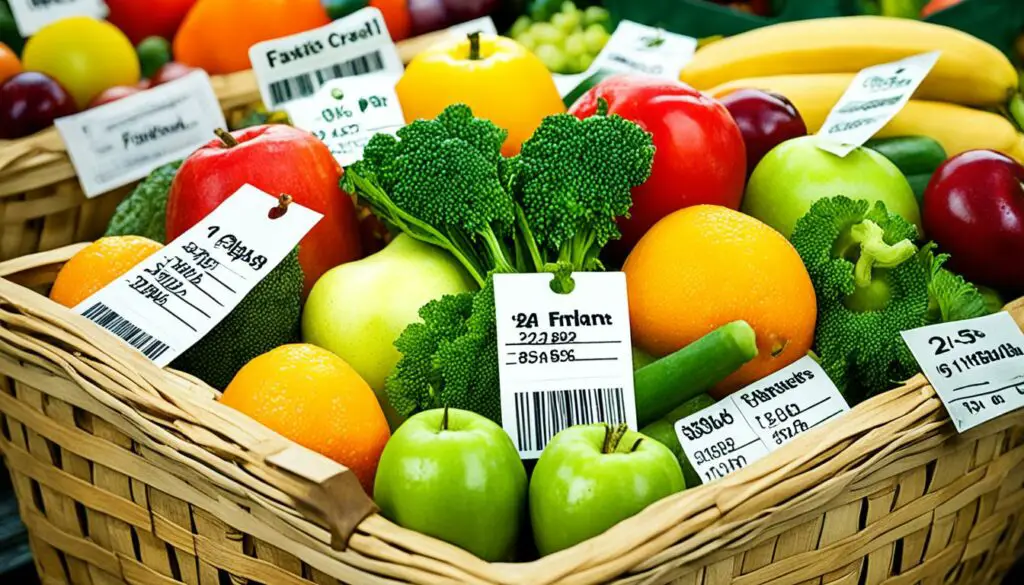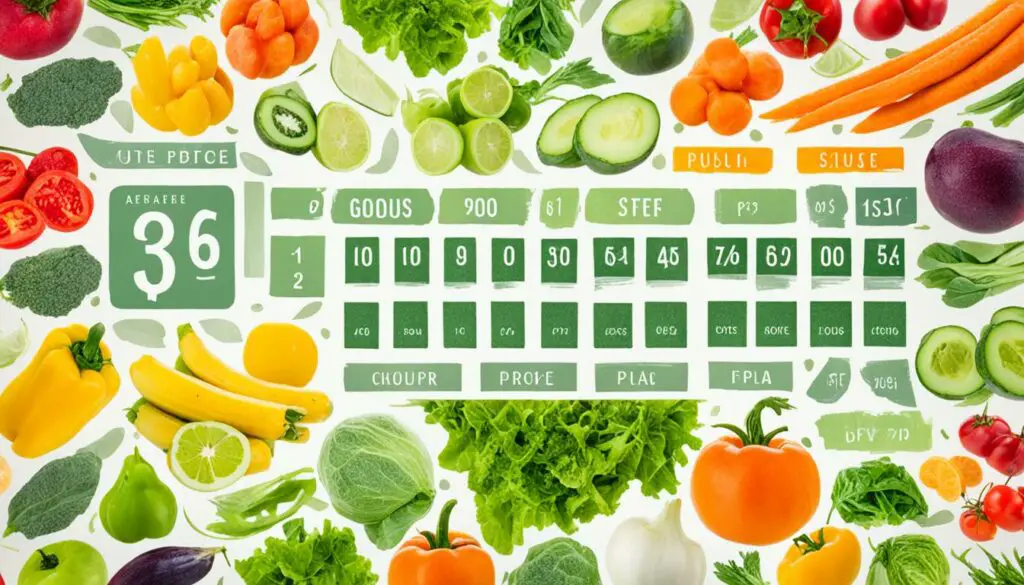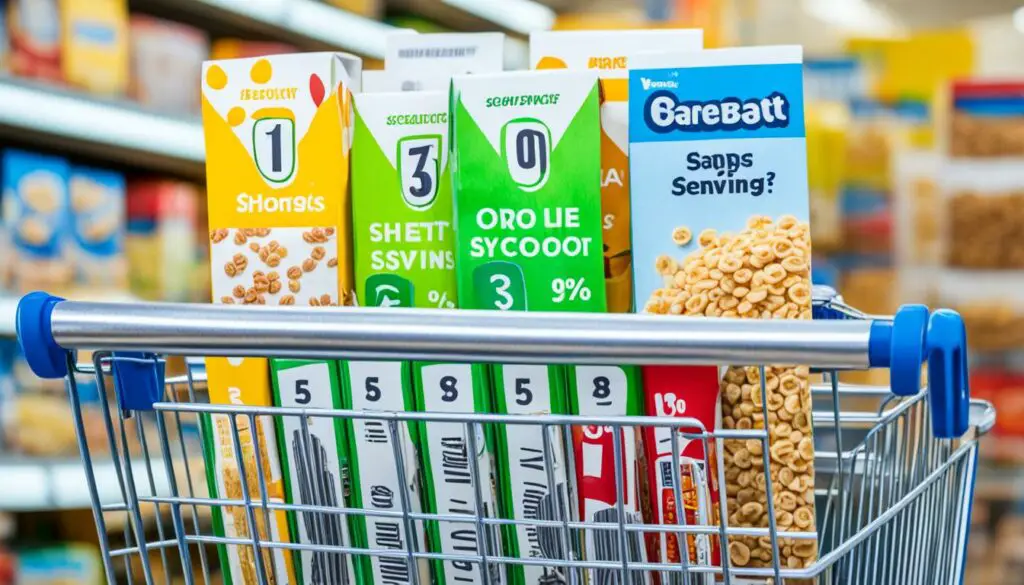Originally posted on February 10, 2024 @ 6:43 pm
When it comes to grocery shopping, have you ever wondered how prices are determined? Grocery store markup rates play a crucial role in setting retail prices and can vary widely depending on the product. Understanding these markups can help you make informed purchasing decisions and save money at the grocery store.
Table of Contents
Key Takeaways:
- Grocery store markup rates can vary, with the average markup being around 15%.
- Some items have significantly higher markups, such as batteries, produce, pre-cut produce, bottled water, cereal, baked goods, and spices.
- You can save money by buying batteries in bulk, opting for tap water instead of bottled water, and choosing store brands for cereal, baked goods, and spices.
- Stocking up on sale produce and cutting your own fruits and vegetables can also help you avoid high markups.
- Grocery store profit margins are generally low, influenced by factors like competition, demographics, and pricing strategies.
The Steepest Markups at the Grocery Store

When it comes to grocery shopping, understanding the markups on various items can help you make smarter purchasing decisions and save money. Some grocery store items have particularly high markups, which means you could be paying significantly more than the wholesale cost. Let’s take a closer look at some of the items with the steepest markups so that you can be mindful of them during your next shopping trip.
Batteries – Markup of up to 70%
It’s no surprise that batteries have one of the highest markups in the grocery store. This essential item often comes with a hefty price tag. Retailers know that people need batteries and are often willing to pay a premium for them. The next time you’re in need of batteries, consider buying them in bulk at warehouse stores like Costco or Sam’s Club. This simple switch can save you up to 40 cents per battery, which can add up over time.
Produce and Pre-cut Produce – Markups of 50-75%
Another category of grocery items with high markups is produce, particularly pre-cut produce. Retailers often charge a premium for the convenience of pre-cut fruits and vegetables. To save money, consider taking a few extra minutes to cut your own produce at home. This small effort can help you avoid paying three times more for the same items.
Bottled Water – Significant Markups
While the convenience of bottled water may be enticing, it often comes with a steep markup. Instead of regularly purchasing bottled water, consider opting for tap water and carrying a reusable bottle. Not only will this be more cost-effective, but it’s also an eco-friendly choice.
Cereal, Baked Goods, and Spices – Noticeable Markups
Cereal, baked goods, and spices are other grocery items that tend to have significant markups. Retailers know that these are staple items for many households, and consumers are generally willing to pay a higher price for them. To save money, keep an eye out for sales and coupons on these items. Additionally, consider trying store brands, as they can offer similar quality at a lower cost.
Being aware of the steepest markups at the grocery store can empower you to make more informed purchasing decisions. By considering alternative options, buying in bulk, and taking advantage of sales, you can save money while still getting the items you need.
| Item | Markup Range |
|---|---|
| Batteries | Up to 70% |
| Produce and Pre-cut Produce | 50-75% |
| Bottled Water | Significant Markups |
| Cereal | Noticeable Markups |
| Baked Goods | Noticeable Markups |
| Spices | Noticeable Markups |
Now that you are aware of the steepest markups at the grocery store, you can approach your shopping trips with a keen eye for savings. Remember to consider alternatives, buy in bulk, and take advantage of sales and discounts to make the most of your grocery budget.
Saving Money on Batteries

Retailers markup batteries because they know people will likely buy them regardless of the price. However, there are ways to save money on batteries and avoid overpaying at the grocery store. One effective strategy is to buy batteries in bulk at warehouse stores like Costco or Sam’s Club. By purchasing larger quantities, you can take advantage of discounted prices and significantly reduce your battery expenses.
Buying batteries in bulk offers several benefits. Firstly, it allows you to save money per battery compared to buying individual packs at grocery stores. Typically, warehouse club stores offer batteries at lower unit prices, resulting in significant savings over time.
For example, let’s say a pack of four AA batteries costs $5 at the grocery store, which amounts to $1.25 per battery. However, if you buy a bulk pack of twenty AA batteries at a warehouse store for $8, the unit price drops to just 40 cents per battery. This simple switch can save you up to 85 cents per battery or more, depending on the brand and quantity.
Buying batteries in bulk can save you up to 40 cents per battery, resulting in significant savings over time.
Another advantage of buying batteries in bulk is that you’ll always have extras on hand, reducing the risk of running out at inconvenient times. Instead of having to rush to the store and pay a premium for emergency batteries, you can simply grab a fresh set from your bulk supply.
Furthermore, buying batteries in bulk is not only cost-effective but also environmentally friendly. By reducing the amount of packaging and waste generated by individual battery packs, you contribute to a more sustainable lifestyle.
Alternatives to Buying Batteries at the Grocery Store
While buying in bulk is an excellent way to save money on batteries, it’s not the only alternative to purchasing them at the grocery store. There are a few other options worth considering:
- Online retailers: Online platforms like Amazon offer competitive prices, discounts, and bulk options for batteries. Shopping online allows you to conveniently compare prices and reviews, ensuring you get the best deal.
- Rechargeable batteries: Investing in rechargeable batteries and a charger can provide long-term savings. While the upfront cost might be higher, rechargeable batteries can be used multiple times, reducing the need for frequent battery replacements.
- Eco-friendly options: Consider eco-friendly alternatives to traditional disposable batteries, such as solar-powered or rechargeable batteries with higher energy capacity. These options may be costlier initially, but they offer long-term savings and help reduce environmental impact.
With these alternatives in mind, you can make informed decisions and choose the most cost-effective and sustainable battery options for your needs.
| Retailer | Price per Battery |
|---|---|
| Grocery Store | $1.25 |
| Warehouse Store (bulk) | $0.40 |
| Online Retailer (pack of 24) | $0.50 |
| Rechargeable Batteries | Varies (upfront cost) |
Note: Prices are approximate and may vary depending on location and brand.
Tips for Saving Money on Produce

When it comes to buying groceries, produce can often be one of the most expensive items on your shopping list. However, with some smart shopping strategies, you can save money on produce without sacrificing quality. Here are some tips to help you stretch your grocery budget:
1. Buy produce on sale
One of the easiest ways to save money on produce is to purchase items that are on sale. Grocery stores often discount produce that is in-season and available in abundance. These sales are a great opportunity to stock up on your favorite fruits and vegetables at a lower price. Keep an eye out for weekly circulars or check the store’s website for current deals. Buying produce on sale can help you save significantly on your grocery bill.
2. Consider freezing produce
Another way to save money on produce is to freeze it. When you find a great deal on fruits or vegetables, buy in bulk and freeze the extras for later use. Freezing preserves the freshness and nutritional value of produce, allowing you to enjoy it even when it’s out of season. You can freeze fruits for smoothies or baking, and vegetables for soups or stir-fries. Just make sure to properly wash and prepare the produce before freezing.
3. Plan your meals around produce sales
Planning your meals based on the produce that is on sale can help you save money and reduce food waste. Take a look at the weekly sales flyers or browse online to see what fruits and vegetables are available at a discounted price. Then, plan your meals for the week accordingly. By incorporating sale items into your meal plan, you can take advantage of the lower prices and enjoy a variety of fresh, healthy meals.
By implementing these tips, you can save money on produce and make the most of your grocery budget. Keep in mind that buying in-season and on sale produce not only saves you money but also ensures that you’re getting the freshest and most flavorful fruits and vegetables.
| Produce | Average Price | Sale Price | Savings |
|---|---|---|---|
| Apples | $1.50/lb | $0.99/lb | $0.51/lb |
| Broccoli | $2.99/bunch | $1.99/bunch | $1.00/bunch |
| Oranges | $0.75/each | $0.50/each | $0.25/each |
Example of potential savings when buying produce on sale:
“I always check the produce section for sales. Last week, I found a great deal on strawberries, so I bought a few pounds and froze them for smoothies. Not only did I save money, but I also have delicious berries all year round!”
Remember, saving money on produce doesn’t mean compromising on quality or nutrition. With a little planning and savvy shopping, you can enjoy fresh, affordable produce while keeping your grocery budget intact.
Avoiding the Markup on Pre-Cut Produce

When it comes to grocery shopping, convenience often comes at a price. Pre-cut fruits and vegetables are a prime example of this. While they offer the advantage of saving time in the kitchen, they also come with a hefty markup that can put a dent in your wallet. By taking a few extra minutes to cut your own produce at home, you can avoid this unnecessary expense and save some money in the process.
Pre-cut produce is typically priced at a premium due to the additional labor and packaging involved. On average, pre-cut fruits and vegetables have a markup that is three times higher than their whole counterparts. So, that convenient package of pre-cut pineapple chunks or pre-sliced bell peppers can end up costing you significantly more than buying the whole fruit or vegetable and preparing it yourself.
By opting to cut your own produce at home, you have greater control over the quality, freshness, and portion size. Additionally, you can ensure that you are getting the maximum value for your money. Cutting your own produce may seem like a small inconvenience, but the savings can add up over time.
Benefits of Cutting Produce at Home:
- Saving Money: Cutting your own produce allows you to avoid the markup on pre-cut fruits and vegetables, helping you stretch your grocery budget further.
- Fresher Produce: By cutting your produce at home, you can ensure that it is fresh and hasn’t been sitting on the store shelves for an extended period.
- Reducing Food Waste: Buying whole produce gives you the flexibility to use every part of the fruit or vegetable, minimizing food waste.
- Customization: Cutting your produce at home allows you to tailor the size and shape of the pieces to suit your specific recipes or preferences.
When it comes to cutting produce at home, having the right tools can make the process easier and more efficient. Invest in a good quality knife set and a cutting board to ensure safety and precision. Remember to wash your produce before cutting, even if it has been pre-washed or labeled as “ready to eat.”
So, the next time you’re browsing the produce section at the grocery store, consider skipping the pre-cut options and choose whole fruits and vegetables instead. Not only will you save money, but you’ll also have the satisfaction of knowing that you’re getting the most value out of your purchase.
| Produce Item | Pre-Cut Price (per pound) | Whole Price (per pound) | Savings |
|---|---|---|---|
| Pre-Cut Pineapple | $4.99 | $1.99 | $3 per pound |
| Pre-Sliced Bell Peppers | $3.49 | $1.29 | $2.20 per pound |
| Pre-Washed Salad Mix | $5.99 | $2.99 | $3 per pound |
As you can see from the table above, the savings can be significant when you choose to cut your own produce. So, put on your chef’s hat and get ready to enjoy fresh, affordable fruits and vegetables by avoiding the markup on pre-cut produce.
Opting for Tap Water Instead of Bottled Water

Bottled water is a popular choice for many people, but it comes at a steep price. Not only is it expensive, but the environmental impact of single-use plastic bottles is also a concern. By making a simple switch and opting for tap water, you can save money while also reducing waste. Here’s why choosing tap water and using reusable water bottles is a smart and eco-friendly choice.
Tap water is a cost-effective alternative to bottled water. The markup on bottled water is significantly higher than tap water, making it an expensive option in the long run. By switching to tap water, you can avoid paying extra for unnecessary packaging and marketing costs.
Using reusable water bottles is another practical and money-saving solution. Instead of buying single-use plastic bottles, invest in a high-quality reusable water bottle that you can refill whenever needed. Not only will this save you money, but it will also contribute to reducing plastic waste and its impact on the environment.
According to studies, the average American spends around $100 per year on bottled water. By choosing tap water and using a reusable water bottle, you can save a significant amount of money over time. Imagine what you could do with that extra cash in your pocket!
Not only does opting for tap water and reusable water bottles save you money, but it also helps to conserve natural resources and reduce carbon emissions. By reducing the demand for bottled water, we can alleviate the strain on our water sources and lessen the production of plastic bottles, which contribute to pollution and climate change.
“Choosing tap water and using reusable water bottles isn’t just about saving money; it’s about making a conscious choice to protect the planet we call home.”
In conclusion, adopting the habit of choosing tap water instead of bottled water and using reusable water bottles is a win-win situation. Not only will it help you save money in the long run, but it will also contribute to a more sustainable and eco-friendly lifestyle. So, fill up your reusable water bottle, enjoy the refreshing taste of tap water, and make a positive impact on your budget and the environment.
Finding Deals on Breakfast Cereal

Cereal is a staple in many households, but saving money on your favorite breakfast brands can be a challenge. With markups around 40%, it’s important to apply money-saving strategies and take advantage of sales and coupons to stretch your grocery budget. Additionally, opting for store brands can help you enjoy delicious cereals at a lower cost. Let’s explore how you can find the best deals on breakfast cereal.
1. Look for Sales and Coupons
One of the easiest ways to save money on cereal is by keeping an eye out for sales and coupons. Grocery stores frequently offer promotions and discounts on various cereals. Check your local newspaper, online coupon websites, or the store’s official website for available deals. By combining coupons with sales, you can save even more. Be sure to read the fine print and check for any limitations or expiration dates.
2. Consider Buying Store Brands
Don’t shy away from trying store brands when it comes to cereal. Many grocery stores offer their own versions of popular cereals at a lower price point. These store brands are often just as tasty as name brand cereals, and you can enjoy the same flavors without paying extra for the brand name. Give store brands a chance and discover new favorites while saving money.
3. Compare Unit Prices
When browsing the cereal aisle, pay attention to the unit prices displayed on the shelf tags. Unit prices provide a comparison of the cost per ounce or gram of a particular cereal. This allows you to make an informed decision and identify the best value for your money. Sometimes, larger boxes or bulk packages offer a lower unit price, resulting in long-term savings.
Check out this table showcasing the unit prices of different cereal brands:
| Cereal Brand | Box Size | Price | Unit Price |
|---|---|---|---|
| Cheerios | 12 oz | $3.99 | $0.33 per oz |
| Store Brand | 16 oz | $2.99 | $0.19 per oz |
| Special K | 14 oz | $4.49 | $0.32 per oz |
As you can see, the store brand offers the lowest unit price, resulting in significant savings compared to well-known cereal brands.
4. Bulk Buying and Stocking Up
If you and your family consume a considerable amount of cereal, buying in bulk can be a cost-effective option. Warehouse stores like Costco or Sam’s Club often offer larger boxes or multi-packs of cereals at a discounted price. By purchasing in larger quantities, you can reduce the cost per serving and save money in the long run.
5. Try Local Discount Stores
Don’t overlook local discount stores or dollar stores for cereal deals. These stores often offer discounted prices on a variety of grocery items, including cereal. While the selection may be more limited compared to traditional grocery stores, the savings can be significant.
Did You Know? By applying these money-saving strategies and finding the best deals on breakfast cereals, you can stock up your pantry without breaking the bank. Cutting costs on high-markup items like cereal allows you to allocate more funds to other groceries or savings.
Whether it’s through sales and coupons, buying store brands, comparing unit prices, or utilizing bulk-buying options, there are plenty of ways to save money on breakfast cereal. Incorporate these tips into your grocery shopping routine and enjoy your favorite cereals while keeping your budget intact.
Making Homemade Baked Goods

When it comes to baked goods, the convenience of grabbing a treat from the grocery store can come at a high price. Did you know that store-bought baked goods often have a markup of around 100%? But fear not, there is a way to satisfy your sweet tooth without breaking the bank – by making homemade baked goods!
Making your own baked goods not only allows you to control the ingredients and flavors but also helps you save a significant amount of money. Whether you prefer to bake from scratch or use a mix from a box, the cost of homemade baked goods is substantially lower compared to store-bought options.
By baking at home, you can save money on a variety of treats, including cookies, cakes, bread, muffins, and more. Plus, the process of baking can be a fun and rewarding experience, allowing you to unleash your creativity in the kitchen. Imagine the smell of freshly baked cookies wafting through your home!
“Baking is therapy!” – Paul Hollywood
Not only will you save money by making your own baked goods, but you can also customize them to suit your taste preferences. Experiment with different flavors, add-ins, and decorations to create unique and delicious treats that are truly one-of-a-kind.
So, get your apron on, preheat your oven, and let your inner baker shine by making homemade baked goods. Whether you’re baking for yourself, family, or friends, the satisfaction of enjoying your own creations while saving money is truly priceless.
Tips for Successful Homemade Baking:
- Follow recipes carefully and measure ingredients accurately.
- Invest in basic baking tools such as measuring cups, spoons, mixing bowls, and a baking pan.
- Experiment with different types of flour and sugars to discover your preferred taste and texture.
- Don’t be afraid to try new recipes and techniques – baking is all about exploration and creativity.
- Share your homemade baked goods with others and spread the joy of delicious treats.
Remember, baking at home not only saves you money but also allows you to enjoy the process and create delectable treats customized to your liking. So, grab your favorite recipes, fire up the oven, and let the baking adventures begin!
| Baked Good | Store Price | Homemade Cost | Savings |
|---|---|---|---|
| Chocolate Chip Cookies | $4.99 per dozen | $2.50 per dozen | $2.49 |
| Blueberry Muffins | $2.99 each | $1.20 each | $1.79 |
| Cream Cheese Brownies | $3.99 per piece | $1.50 per piece | $2.49 |
Saving on Spices
Spices are an essential part of any flavorful dish, but they can also come with a hefty price tag. Many grocery stores mark up spices significantly, with prices often exceeding $5 for a small jar. However, there are smart strategies you can employ to save money on spices without compromising on taste.
- Buy in bulk: Purchasing spices in bulk is one of the most effective ways to save money. Look for health food stores or select standard grocery stores that offer bulk spice sections. Buying in bulk allows you to purchase as much or as little as you need, helping you avoid unnecessary expenses. Plus, buying in larger quantities often results in lower prices per ounce.
- Choose generic brands: Opting for generic or private label spices instead of name brand options can lead to significant savings. Generic brands often offer comparable quality at a lower price point. Don’t be afraid to experiment with different brands and compare prices to find the most affordable and flavorful options.
By buying spices in bulk and choosing generic brands, you can save money without compromising on the quality of your culinary creations. Let your taste buds guide you as you explore new spice blends and experiment with different flavor profiles.
Spice Price Comparison
| Spice | Brand | Size | Price |
|---|---|---|---|
| Cinnamon | Brand A | 1.5 oz | $4.99 |
| Cinnamon | Brand B (Generic) | 2 oz | $3.99 |
| Turmeric | Brand A | 2.5 oz | $6.99 |
| Turmeric | Brand B (Generic) | 3 oz | $4.99 |
| Paprika | Brand A | 1 oz | $3.49 |
| Paprika | Brand B (Generic) | 1.5 oz | $2.49 |
“Buying spices in bulk and choosing generic brands not only saves money but also opens up opportunities to explore different spice blends and flavors in your recipes.”
Understanding Grocery Store Profit Margins
Grocery store profit margins play a crucial role in the success of a business. However, these margins are typically low due to various factors. Conventional grocery stores, on average, have profit margins of around 2.2%, while natural, organic, and gourmet stores tend to have higher profit margins, ranging from 5% to 10%. Understanding the factors that influence these profit margins is essential for both grocery store owners and consumers.
Several key factors affect grocery store profit margins:
Competition
Competition plays a significant role in determining profit margins. In areas with high competition, grocery stores may need to lower their prices to attract customers, resulting in lower profit margins. On the other hand, stores with limited competition may have higher profit margins due to the absence of price pressure.
Demographics
The demographics of an area can impact the profit margins of grocery stores. Stores located in affluent neighborhoods may be able to charge higher prices for premium products, leading to higher profit margins. Conversely, stores in low-income areas may need to lower their prices to remain competitive, resulting in lower profit margins.
Pricing Strategies
The pricing strategies employed by grocery stores can also affect profit margins. Stores that focus on offering lower prices on everyday essentials but have higher markups on specialty or niche products may have different profit margins compared to stores that use a different pricing strategy. Additionally, promotional pricing, discounts, and loyalty programs can influence profit margins by attracting or retaining customers.
Understanding these factors is crucial for both grocery store owners and consumers. Store owners need to balance pricing strategies to maximize profit margins while remaining competitive. Consumers can capitalize on this knowledge by comparing prices, taking advantage of loyalty programs, and understanding the relationship between markup and retail price.
By understanding grocery store profit margins and the factors that influence them, both store owners and consumers can make more informed decisions. Store owners can optimize pricing strategies to increase profitability, while consumers can navigate the grocery store landscape more effectively, ensuring they are getting the best value for their money.
The Difference Between Markup and Margin in Grocery Stores
Grocery stores use both markup and margin in determining pricing. Understanding the difference between these terms is crucial for both consumers and retailers. Let’s take a closer look at their definitions and how they are used in retail pricing calculations.
Markup: Setting the Retail Price
Markup refers to the percentage a wholesale cost is marked up to create the selling price. It is often expressed as a percentage of the cost. For example, if an item has a wholesale cost of $10 and a markup of 50%, the selling price would be $15. Markup allows retailers to cover their expenses, such as overhead costs and operating expenses, while generating a profit.
Margin: Tracking Profit or Loss
Margin, on the other hand, refers to the percentage of the retail price that is profit. It is calculated by subtracting the wholesale cost from the retail price and then dividing the result by the retail price. For example, if an item has a retail price of $20 and a wholesale cost of $10, the margin would be 50% ($10 divided by $20). Margin is an essential metric that helps retailers track their bottom-line profit or loss.
Here’s a simple breakdown of the difference between markup and margin:
| Concept | Definition | Calculation |
|---|---|---|
| Markup | The percentage a wholesale cost is marked up to create the selling price | Selling Price = Wholesale Cost + (Wholesale Cost x Markup Percentage) |
| Margin | The percentage of the retail price that is profit | Margin = (Retail Price – Wholesale Cost) / Retail Price |
These calculations play a crucial role in retail pricing, allowing grocery stores to determine their selling prices and track their profitability. It’s important for consumers to understand these concepts to make informed purchasing decisions, while retailers utilize these calculations to ensure sustainable business operations.
Conclusion
Understanding grocery store markups is key to saving money on your grocery shopping. By being aware of which items have the highest markups, you can make more informed purchasing decisions and stretch your grocery budget further.
One effective strategy is to buy in bulk. Warehouse stores like Costco or Sam’s Club offer discounted prices on products, including batteries and other household essentials. Buying in bulk can save you significant amounts of money in the long run.
Choosing store brands over name brands is another smart way to save. Store brands often offer the same quality as name brands at a lower price. Give them a try and you might be pleasantly surprised by the savings you can achieve without sacrificing quality.
In conclusion, with a better understanding of grocery store markups and some savvy shopping techniques, you can make the most of your grocery budget. Remember to be mindful of which items have the highest markups, buy in bulk when possible, and explore store brand options. By implementing these strategies, you can save money and make your grocery shopping experience more cost-effective.
FAQ
How much do grocery stores mark up their products?
Grocery store markups can vary widely, with the average markup being around 15%. However, individual items can have markups as high as 75%.
Which items have the highest markups at the grocery store?
Some of the items with the highest markups include batteries, produce, pre-cut produce, bottled water, cereal, baked goods, and spices.
How can I save money on batteries?
You can save money by buying batteries in bulk at warehouse stores like Costco or Sam’s Club. This simple switch can save you up to 40 cents per battery.
What are some tips for saving money on produce?
To save money on produce, focus on buying produce that is on sale and consider stocking up and freezing it for later use.
How can I avoid the markup on pre-cut produce?
You can save money by taking a few minutes to cut your own produce at home instead of buying pre-cut fruits and vegetables.
How can I save money on bottled water?
Consider carrying and refilling a reusable water bottle instead of buying bottled water. This small change can lead to significant savings over time.
What can I do to find deals on breakfast cereal?
Look for sales and coupons, as they are extremely common for cereal. Additionally, consider buying store brands, as they are often just as tasty at a lower cost.
How can I save money on baked goods?
Instead of buying ready-made baked goods, consider making them at home from scratch or using a mix from a box. This can save you a significant amount of money while still enjoying delicious baked goods.
How can I save on spices?
Consider buying spices in bulk at health food stores or some standard grocery stores. Additionally, choose generic or private label spices over name brand options to save even more.
What are the profit margins for grocery stores?
Grocery store profit margins are generally low, with conventional grocery stores averaging around 2.2%. Natural, organic, and gourmet stores tend to have higher profit margins in the range of 5-10%.
What is the difference between markup and margin in grocery stores?
Markup is used to set the retail price of products, while margin is used to track bottom-line profit or loss. Markup refers to the percentage a wholesale cost is marked up to create the selling price, while margin refers to the percentage of a retail price that is profit.
How can understanding grocery store markups help me save money?
By knowing which items have the highest markups and implementing money-saving strategies, such as buying in bulk and choosing store brands, you can make more informed purchasing decisions and stretch your grocery budget further.
Source Links
- https://www.onegoodthingbyjillee.com/grocery-store-markups/
- https://www.nutritionincentivehub.org/media/imihex0v/grocery-retail-pricing.pdf
- https://thegrocerystoreguy.com/do-grocery-stores-use-markup-or-margin/
See also:
Leave a Reply